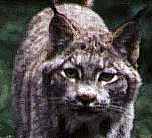
 |
The Lynx Family: FelidaeThe study of fossils and animal history tells us that the handsome lynx was distributed in latest Pleistocene (or Ice Age) times all over the forests of the northern world, from Britain and Ireland in the west of Europe to Newfoundland in eastern North America. It was contemporary with Stone Age man in Britain and Ireland. Its relict type distribution has become accentuated in later historical times, particularly in Europe, where it is now very rare indeed except in some parts of Scandinavia and northern Russia. |
| The systematics of this hunting cat's races (of which there are or were at least eight) have clearly not been fully worked out, especially as regards the (apparently) nameless population that still inhabits parts of Greece and perhaps also still neighbouring parts of the Balkans. This population, another in the Transylvania Alps and Carpathian Mountains of Romania and Russia, the extinct population of Italy and Sicily, the Sardinian race, lynx sardiniae (which is almost certainly also extinct), and the Spanish lynx, lynx pardina, are regarded by some authorities as a species separate from the rest. |  |
 |
It is possible in the
western Carpathians the northern
and pardine groups may coexist; if
so, the pardine lynx should be
regarded as a full species, Lynx
pardina. Fossil evidence supports
this. Source: THE RED BOOK: Wildlife in Danger ©1969, International Union for the Conservation of Nature and Natural Resources (IUCN) page 79 |
| Among a total of 146 lynx stomachs, 114 contained remains from one species only. The remians of two species were found in 25 stomachs, and the remains of three species in 7 stomachs. Among 189 identified prey species, 89% were mammals, and a little more than half of those were some type of deer species. |  |
 |
The study mainly comprised prey
taken in winter, and it is known that
the lynx takes more deer in winter
than at other times of the year. The
low percentage of sheep would
probably increase if the stomach
content of lynx was investigated in
summer, when sheep are grazing
outdoors.
Reference: Birkeland & Myrberget |



